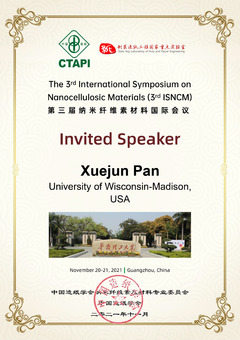
Conference Guide(参会指南): https://isncm2021.aconf.org/news.html
November 19-21, 2021 | Guangzhou, China

Start Time:2021-11-21 08:30 (Asia/Shanghai)
Duration:25min
Session:[SB] The 3rd International Symposium on Nanocellulosic Materials-Oral Session (ROOM 2) » [S5] Oral Session 11 & 12
Tips: The file permissions under this presentation are private. You have not logged in yet and cannot view it temporarily.
Dr. Xuejun Pan is a Professor in the Department of Biological Systems Engineering at the University of Wisconsin-Madison. He earned his Bachelor's, Master's, and Ph.D. degrees in Chemical Engineering (Pulp & Paper) at Tianjin University of Science and Technology, China, and the second Ph.D. degree in Applied Bioscience at Hokkaido University, Japan. Dr. Pan did postdoctoral research at Georgia Tech, the University of Minnesota, and the University of British Columbia before joining the faculty at University of Wisconsin-Madison. Dr. Pan’s research interest is in developing and fundamentally understanding innovative technologies for converting lignocellulosic biomass into liquid fuels, platform chemicals, and functionalized materials. He has published 110+ peer-reviewed journal articles, 6 book chapters, and 5 U.S. patents. Dr. Pan has won numerous awards, including the Andrew Chase Award in 2021, the Vilas Midcareer Award in 2018, the Alfred Toepfer Faculty Fellow Award in 2011, and the NSF Career Award in 2009. He is an elected Fellow of the International Academy of Wood Science. More information can be found at his lab website http://biorefining.bse.wisc.edu/. Email: [email protected]
Comment submit